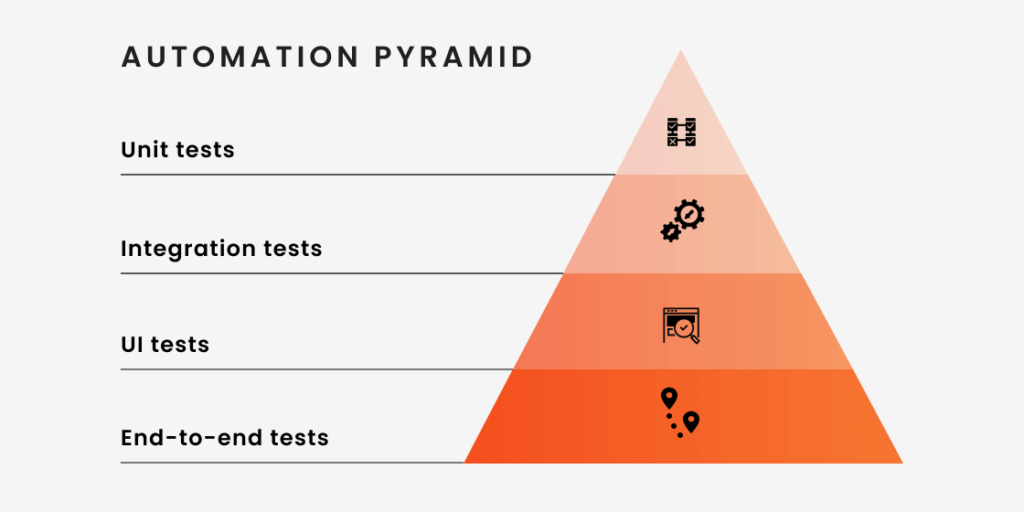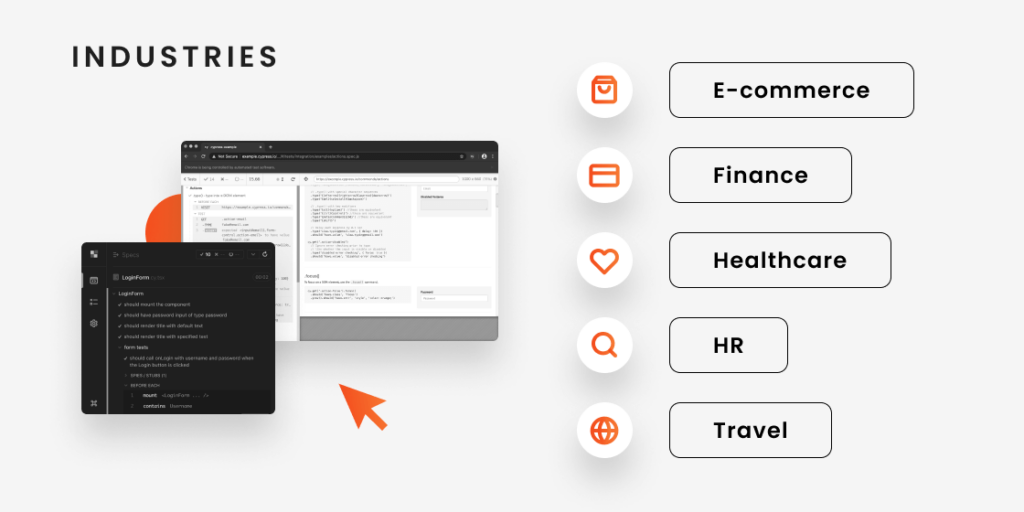Taras Oleksyn, our AQA Team Lead with over 20 years of experience in the field, shared his thoughts during a GoodFirms Roundtable podcast. We have summarized the key points and gathered them into this article.
Let’s start with a few key changes in perception towards automated testing:
- It is a strategic investment now. Automated testing can help businesses to improve the quality of their software, reduce costs, and accelerate their time to market.
- It can be implemented gradually. Automated QA does not have to be done all at once. Businesses can start by automating a subset of essential tests and then gradually expand the scope of automation over time.
- It does not require highly skilled specialists. There are a variety of automated testing tools available that can be used by testers with different skill levels.
Automation Pyramid: A Shift Towards a More Strategic Approach
UI testing was once the most prevalent method in software testing. However, with the advent of new tools and frameworks, there is now a shift towards a more strategic approach to testing, with greater emphasis on compliance with the automation pyramid.
The automation pyramid is a framework that recommends a distribution of tests across different levels:
- Unit tests. Unit tests are small, isolated tests that verify the functionality of individual units of code.
- Integration tests. Integration tests verify the functionality of multiple units of code working together.
- UI tests. UI tests verify the functionality of the user interface.
- End-to-end tests. End-to-end tests verify the functionality of the entire system, from start to finish.
The automation pyramid recommends that a large volume of unit tests be written, followed by a moderate number of integration tests, and a minimal set of UI and end-to-end tests. This approach helps to reduce the time and effort required for testing, while still ensuring that the system is thoroughly tested.

How to Integrate Automated Testing into an Existing Testing Strategy
Here are some best practices and strategies for gradually introducing automation into an established manual testing process:
- Assess project context and maturity. Consider the specific needs of your project and its current stage of development before deciding to integrate automation. If your application is still under development or your manual testing process is not well-defined, it may be too early to automate.
- Engage stakeholders. Get buy-in from all stakeholders, including developers, testers, and management. Understand their concerns about automation and how it can benefit the project.
- Start with a smoke suite. Prioritize automating the most critical test cases to ensure that essential functionality is working as expected.
- Tailor your automation strategy to your project’s needs. Consider your project’s development approach and testing strategy when choosing automation tools and frameworks. For example, if you are using BDD, you can integrate it with your automation strategy. However, if you need a framework that is easy for manual testers to use, consider building a keyword-driven framework.
Here is an example of how to gradually introduce automation into an established manual testing process:
- Identify the areas of your testing process that are most repetitive and time-consuming. These are the areas that will benefit the most from automation.
- Select a subset of test cases from these areas to automate. Start with a small number of test cases that are essential for ensuring the quality of your software.
- Choose the right automation tools and framework for your needs. There are a variety of tools and frameworks available, so it is important to choose ones that are appropriate for your project and your team.
- Develop a plan for implementing automation. This plan should include a timeline, resources, and risk management strategy.
- Train your team on how to use the automation tools and framework.
- Implement automation gradually. Start by automating a small number of test cases and then gradually expand the scope of automation over time.
- Monitor the results of your automation efforts and make adjustments as needed.
Automated Testing Guide
Discover how to boost your business with automated testing
Benefits of Gradually Introducing Automation
There are several benefits to gradually introducing automation into your testing process:
- It reduces the risk of disruption. Automating too much too quickly can be disruptive to your testing process and lead to problems with your software releases.
- It allows you to learn from your mistakes. As you automate more and more test cases, you will learn from your mistakes and improve your automation process.
- It helps you to build a sustainable automation practice. Automating too much too quickly can lead to burnout and turnover among your team members. By gradually introducing automation, you can build a sustainable automation practice that will benefit your organization in the long term.
By following these best practices and strategies, you can successfully integrate automated testing into your existing testing strategy and improve the quality of your software.
As we wrap up this section and pivot towards the ethical implications of AQA, remember: the power of automated testing is not in its ability to replace humans, but in its capacity to amplify their capabilities. We’re at a crossroads where the decisions we make about automation can streamline processes and elevate quality—if we navigate with care and foresight.
Unlock a new era of product quality with automation testing
Donec nec enim non dolor faucibus efficitur.
Automated Testing and Collaboration Between Developers, Testers, and Other Stakeholders
Automated testing can have a significant impact on the overall collaboration between developers, testers, and other stakeholders involved in the software development lifecycle. Here are some of the key ways in which automation can impact collaboration:
- Improved communication — a common language and framework for discussing and resolving bugs.
- Shared understanding of the requirements and functionality of the software, which can lead to better collaboration and decision-making.
- Increased transparency achieved through providing stakeholders with real-time visibility into the testing process and results.
- Reduced friction between developers and testers through freeing up testers to focus on more exploratory and strategic testing activities.
Potential Challenges and Adjustments
While automated testing offers many benefits for collaboration, there are also some potential challenges and adjustments that may be required to foster effective collaboration. Here are a few examples:
- Some developers and testers may be resistant to change, and they may need to be educated on the benefits of automated testing.
- It is important to get buy-in from all stakeholders for automated testing to be successful. This means getting everyone on the same page about the goals of automation and how it will be implemented.
- Automated testing may require some cultural changes within the organization, such as a shift towards a more collaborative and DevOps-minded approach to software development.
Considerations for Incorporating Automated Tests Into CI/CD Pipelines
When incorporating automated tests into CI/CD pipelines, there are a few key considerations to keep in mind:
- Choose the right tests to automate. Not all tests are suitable for automation. It is important to choose the right tests to automate based on factors such as the frequency with which they need to be run, the complexity of the tests, and the return on investment.
- Integrate automated tests with CI/CD tools. There are a variety of CI/CD tools available that can be used to integrate automated tests into the pipeline. Choose a tool that is compatible with your existing infrastructure and that meets your specific needs.
- Consider the test environment. Automated tests may need to be run in multiple environments, such as development, staging, and production. It is important to ensure that the test environment is properly configured and that the automated tests are compatible with each environment.
- Monitor the results of automated tests. You have to monitor the results of automated tests closely and to investigate any failures promptly. This will help to ensure that the quality of the software is maintained throughout the CI/CD pipeline.
Ethical Considerations and the Future of Automated Testing
While automation can significantly reduce the time required for repetitive testing—some reports suggest by as much as 60% — it cannot entirely replace the nuanced judgment of experienced testers. Automation excels in consistency, performing the same tests the same way every time, which is a boon for regression testing where the same areas of an application are tested repeatedly to ensure new changes haven’t introduced errors.
However, the reliance on automated testing raises concerns about reduced human involvement. There’s an argument that over-automation could lead to a decline in critical thinking, where testers may not question the integrity of automated tests as deeply. For instance, if an automated test suite is poorly designed, it will execute without identifying significant defects, essentially providing a false sense of security. This can be particularly risky in complex scenarios where human insight is crucial.
Companies tend to experience situations where automated testing overlooked defects that were later caught by manual testing. This statistic underscores the importance of maintaining a balance between automated and manual testing.
In conclusion, while automated testing is an invaluable component of modern software development, it must be integrated thoughtfully. It should augment, not replace, the critical analysis provided by skilled human testers. By doing so, developers can mitigate the risks and uphold the quality of the software.

Industries and Domains That Can Benefit the Most From Automated Testing
Almost every industry and domain can benefit from automated testing, but some sectors benefit more than others. These sectors include:
- E-commerce. E-commerce websites typically have a large number of users and transactions, which can make manual testing difficult and time-consuming. Automated testing can help to ensure that e-commerce websites are reliable and scalable.
- Finance. Financial institutions need to ensure that their software is highly accurate and secure. AQA allows us to identify and fix bugs quickly, and it can also be used to simulate stress conditions to ensure that the software can withstand high loads.
- Healthcare. Healthcare software needs to be extremely reliable and accurate, as any errors could have serious consequences for patients.
- HR. HR software is often used to manage sensitive employee data, so it is important to ensure that it is secure and reliable.
- Travel. Travel websites typically have a large number of users and transactions, which can make manual testing difficult and time-consuming.
In conclusion, integrating automated testing into an existing manual testing strategy should not be an impulsive shift but a considered evolution. The key to a successful transition is to start small, prioritize critical test cases, and gradually scale up, ensuring that each step provides tangible benefits without disrupting existing processes. This approach allows teams to build confidence in the new system, refine their skills, and understand the nuances of automated testing. It is about enhancing the effectiveness of the testing team, not replacing their expertise. Ultimately, a thoughtful integration of automated testing can lead to a more robust, efficient, and high-quality software development lifecycle.





